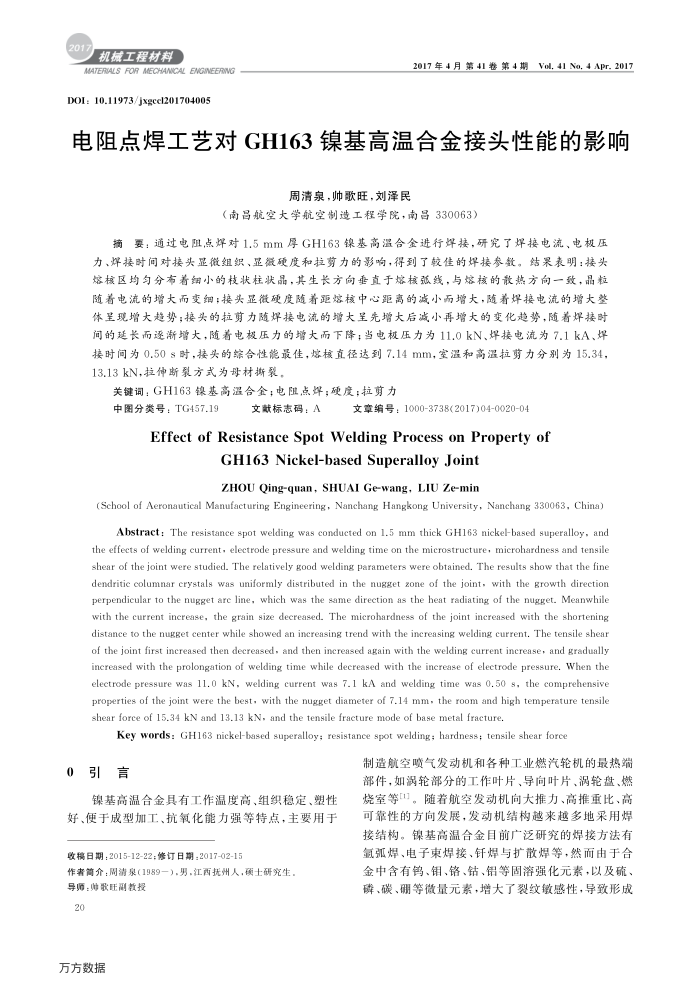电阻点焊工艺对GH163镍基高温合金接头性能的影响
内容简介
 厂机械工程材料
厂机械工程材料AMATERALS FOR MECHANICAL ENGINERIWG D0I: 10.11973/jxgccl201704005
2017年4月第41卷第4期Vol,41 No,4Apr.2017
电阻点焊工艺对GH163镍基高温合金接头性能的影响
周清泉,帅歌旺,刘泽民
(南昌航空大学航空制造工程学院,南昌330063)
摘要:通过电阻点焊对1.5mm厚GH163镍基高温合金进行焊接,研究了接电流、电极压力、婵接时间对接头显微组织、显微硬度和拉剪力的影响,得到了较佳的焊接参数。结果表明:接头熔核区均匀分布着细小的枝状柱状品,其生长方向垂直于熔核弧线,与熔核的散热方向一致,晶起随着电流的增大而变细;接头显微硬度随着距熔核中心距高的减小而增大,随着焊接电流的增大整体呈现增大趋势;接头的拉剪力随焊接电流的增大呈先增大后减小再增大的变化趋势,随着焊接时间的延长而逐渐增大,随着电极压力的增大而下降;当电极压力为11.0kN、焊接电流为7.1kA、焊接时间为0.50s时,接头的综合性能最佳,熔核直径达到7.14mm,室温和高温拉剪力分别为15.34, 13.13kN,拉伸断裂方式为母材撕裂
关键词:GH163镍基高温合金;电阻点焊;硬度;拉剪力
中图分类号:TG457.19
文献标志码:A
文章编号:1000-3738(2017)04-0020-04
Effect ofResistanceSpotWeldingProcess onPropertyof
GH163 Nickel-based Superalloy Joint ZHOU Qing-quan,SHUAI Ge-wang,LIU Ze-min
(School of Aeronautical Manufacturing Engineering, Nanchang Hangkong University, Nanchang 330063, China)
Abstract: The resistance spot welding was conducted on 1.5 mm thick GH163 nickel-based superalloy, and the effects of welding current, electrode pressure and welding time on the microstructure, microhardness and tensile shear of the joint were studied. The relatively good welding parameters were obtained. The results show that the fine dendritic columnar crystals was uniformly distributed in the nugget zone of the joint, with the growth direction perpendicular to the nugget are line, which was the same direction as the heat radiating of the nugget, Meanwhile with the current increase, the grain size decreased. The microhardness of the joint increased with the shortening distance to the nugget center while showed an increasing trend with the increasing welding current. The tensile shear of the joint first increased then decreased, and then increased again with the welding current increase, and graduall increased with the prolongation of welding time while decreased with the increase of electrode pressure. When the eleetrode pressure was 11.0 kN, welding current was 7.1 kA and welding time was 0.50 s, the comprehensiv properties of the joint were the best, with the nugget diameter of 7.14 mm , the room and high temperature tensile shear force of 15.34 kN and 13.13 kN, and the tensile fracture mode of base metal fracture.
Key words: GH163 nickel-based superalloy; resistance spot welding; hardness; tensile shear force
引言 0
镍基高温合金具有工作温度高、组织稳定、塑性
好、便于成型加工、抗氧化能力强等特点,主要用于收稿日期:2015-12-22;修订日期:2017-02-15
作者筒介:周清泉(1989一),男,江西抚州人,硕士研究生,
导师:姚取旺副教投 20
万方数据
制造航空喷气发动机和各种工业燃汽轮机的最热端部件,如涡轮部分的工作叶片、导向叶片、涡轮盘、燃烧室等11。随着航空发动机向大推力、高推重比、高可靠性的方向发展,发动机结构越来越多地采用焊接结构。镍基高温合金目前广泛研究的焊接方法有氧弧焊、电子束焊接、钰焊与扩散焊等,然而由于合金中含有钨、钼、铬、钻、铝等固溶强化元素,以及硫、磷、碳、硼等微量元素,增大了裂纹敏感性,导致形成